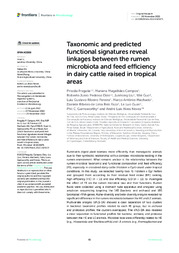Taxonomic and predicted functional signatures reveal linkages between the rumen microbiota and feed efficiency in dairy cattle raised in tropical areas.
Taxonomic and predicted functional signatures reveal linkages between the rumen microbiota and feed efficiency in dairy cattle raised in tropical areas.
Author(s): FREGULIA, P.; CAMPOS, M. M.; DIAS, R. J. P.; LIU, J.; GUO, W.; PEREIRA, L. G. R.; MACHADO, M. A.; REIS, D. R. de L.; GUAN, L. L.; GARNSWORTHY, P. C.; NEVES, A. L. A.
Summary: Ruminants digest plant biomass more efficiently than monogastric animals due to their symbiotic relationship with a complex microbiota residing in the rumen environment. What remains unclear is the relationship between the rumen microbial taxonomic and functional composition and feed efficiency (FE), especially in crossbred dairy cattle (Holstein x Gyr) raised under tropical conditions. In this study, we selected twenty-two F1 Holstein x Gyr heifers and grouped them according to their residual feed intake (RFI) ranking, high efficiency (HE) (n = 11) and low efficiency (LE) (n = 11), to investigate the effect of FE on the rumen microbial taxa and their functions. Rumen fluids were collected using a stomach tube apparatus and analyzed using amplicon sequencing targeting the 16S (bacteria and archaea) and 18S (protozoa) rRNA genes. Alpha-diversity and beta-diversity analysis revealed no significant difference in the rumen microbiota between the HE and LE animals. Multivariate analysis (sPLS-DA) showed a clear separation of two clusters in bacterial taxonomic profiles related to each FE group, but in archaeal and protozoal profiles, the clusters overlapped. The sPLS-DA also revealed a clear separation in functional profiles for bacteria, archaea, and protozoa between the HE and LE animals. Microbial taxa were differently related to HE (e.g., Howardella and Shuttleworthia) and LE animals (e.g., Eremoplastron and Methanobrevibacter), and predicted functions were significatively different for each FE group (e.g., K03395?signaling and cellular process was strongly related to HE animals, and K13643?genetic information processing was related to LE animals). This study demonstrates that differences in the rumen microbiome relative to FE ranking are not directly observed from diversity indices (Faith?s Phylogenetic Diversity, Pielou?s Evenness, Shannon?s diversity, weighted UniFrac distance, Jaccard index, and Bray?Curtis dissimilarity), but from targeted identification of specific taxa and microbial functions characterizing each FE group. These results shed light on the role of rumen microbial taxonomic and functional profiles in crossbred Holstein × Gyr dairy cattle raised in tropical conditions, creating the possibility of using the microbial signature of the HE group as a biological tool for the development of biomarkers that improve FE in ruminants.
Publication year: 2022
Types of publication: Journal article
Unit: Embrapa Dairy Cattle
Keywords: Bovino, Composição microbiana, Eficiência alimentar, Gado Leiteiro, Microbiota
Observation
Some of Embrapa's publications are published as ePub files. To read them, use or download one of the following free software options to your computer or mobile device. Android: Google Play Books; IOS: iBooks; Windows and Linux: Calibre.
Access other publications
Access the Agricultural Research Database (BDPA) to consult Embrapa's full library collection and records.
Visit Embrapa Bookstore to purchase books and other publications sold by Embrapa.

